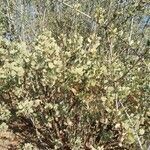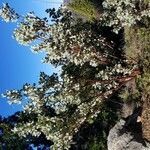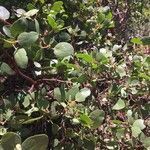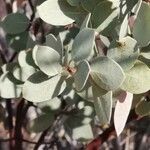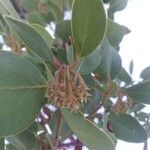Shrubs or trees, erect, mound-forming, 1-8 m; burl absent; twigs usually glabrous, some-times short-hairy or glandular-hairy. Leaves: petiole 7-15 mm; blade white-glaucous, dull, oblong-ovate to ± orbiculate, 2.5-5 × 2-4 cm, base rounded, truncate, or slightly lobed, margins entire, plane, surfaces smooth, glabrous. Inflorescences panicles, 4-8-branched; immature inflorescence pendent, branches spreading, axis 2-3 cm, 1+ mm diam., usually glabrous, sometimes short-hairy or glandular-hairy; bracts not appressed, (spreading), scalelike, deltate, 3-6 mm, (fleshy), apex mucronate, surfaces glabrous; (buds exposed). Pedicels 8-10 mm, finely glandular-hairy. Flowers: corolla white, conic to urceolate; ovary densely glandular-viscid. Fruits globose, 12-15 mm diam., glabrous, (viscid). Stones connate into single sphere. 2n = 26.
More
A large shrub or small tree. It grows 3-6 m high. The bark is red brown. The leaves are dull greyish-green. The leaves are 35 mm long. They are oval in shape. The flowers are white or pink. The fruit grow in clusters. The fruit are white but turn red then black.
Can be grown by cuttings, divisions or seedlings. Seeds needs soaking.
